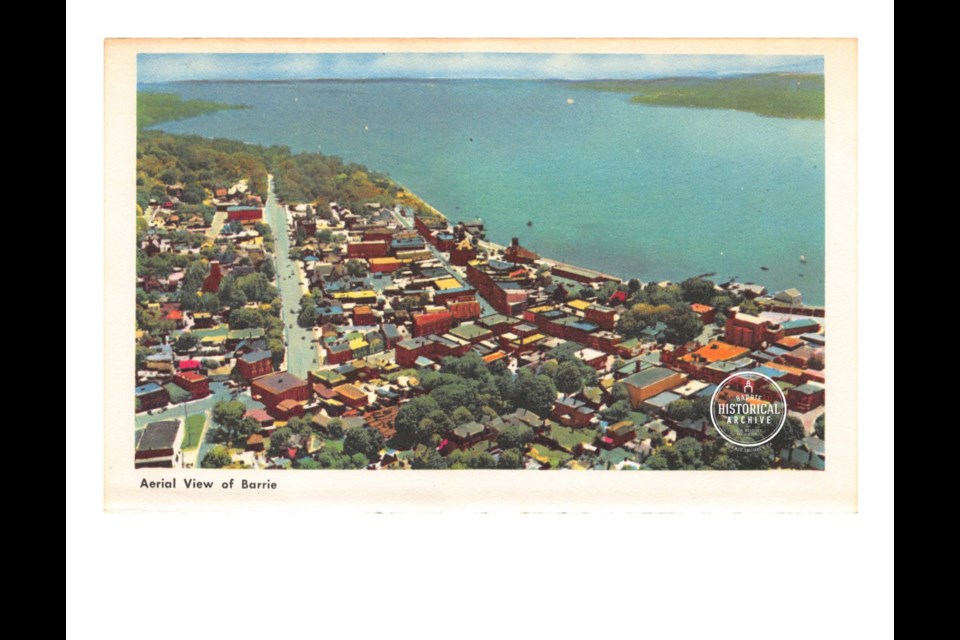Dolores has been gifted with an ability to see things that aren’t necessarily apparent to everyone else.
She has an extra sense, you might say.
Dolores doesn’t live in Barrie anymore, but she remembers well some of her more unusual experiences in the oldest section of this town.
In the 1980s, her life centred around the Five Points area. She rented an apartment above the Sam the Record Man store, which burned down the following decade. Today, the lot is vacant and serves as the patio for Made in Mexico.
Dolores was employed only steps away in the Woolworth’s diner.
On the south side of Ross Street at Bayfield Street, just above Collier Street, the Ball Planing Mill once stood. It was a large, solid brick structure and a landmark for many years. Built in 1885 to replace a string of wooden predecessors that had met with destructive fires, it remained on the site until the late 1950s.
After Ball vacated the lot and moved to Anne Street, this corner changed drastically. The F.W. Woolworth Company had arrived in Barrie by 1916 and had occupied the space at 26 Dunlop St. E., since that time.
After some 40 years at that location, Woolworth’s had definitely outgrown its 490-square-foot store and was on the hunt for a new venue.
This was the golden age of the big department store. Mid-20th century progress embraced all things modern and efficient: supermarkets, laundromats, car washes and record stores.
In 1960, it was high time that Barrie had a shining example of modernity where consumers could shop for just about anything from bicycles to wigs under one roof. That year, an F.W. Woolworth store was announced for the about to be constructed shopping plaza planned for the Anne Street bridge area.
Woolworth’s was booming. In 1960, the company was preparing to open 33 new stores in Canada and, even though Barrie had a fine new Woolworth's store in its west end, the small but expanding market town seemingly had room for another.
In late 1961, demolition began on the buildings on the west side of Bayfield Street from the new Loblaws store all the way up to Ross Street. Down came Jeanne’s Coffee Shop, Livingston IDA Drugs, Barrie Radiator, and London Life Insurance to make way for what was billed as somewhat of an experiment for the company.
Many departments in the new Woolworth’s, from greeting cards to pharmacy and beauty salon, would be contracted out to local merchants. The new 39,000-sq.-ft. store, the largest of the chain in Canada, was estimated to cost up to $350,000 to erect.
One of the most beloved features of any Woolworth's location was almost certainly the luncheonette. These refreshment stands started off in a small way in 1910 in a handful of New York City locations offering only hot dogs and root beer. From there, their popularity grew rapidly and most former Woolworth's customers have fond memories of cream pies, clubhouse sandwiches and roast turkey plates.
The Bayfield Street Woolworth’s luncheonette opened, along with the department store, in June 1962. It offered 38 seats at a bay-style lunch counter and a further 52 seats at tables and in booths.
So successful was the downtown Woolworth’s store that within five years, a massive expansion was necessary. At a cost of $2 million, the store more than doubled in size and grew to 80,000 sq. ft., spread to Maple Street and excavated down to create a 60-car underground parking garage. The enlargement project was dubbed Expando ’67.
The luncheonette was also revamped and given the new name of the Portage Room. A naming contest had been held and local high school student, Gordon Bell, had picked the winner, a nod to the beginning of the Nine Mile Portage within sight of the department store.
It was a busy place through the following decades – yearly breakfasts with Santa Claus, high school hangout for Cokes and smokes, a tall chocolate sundae for a well-behaved child, or a place to set down the shopping bags and have a break.
Most of her shifts were uneventful, but Dolores and some of her co-workers were sometimes puzzled by the inexplicable sudden start-up of the deep fryers in the cafeteria. Not only did they turn on without being touched, but the oil was instantly hot and bubbling, something that seemed to be impossible.
Dolores also recalls a strange event that occurred one day as she began an early shift. The cafeteria hadn’t yet opened, but Dolores saw that a man was already seated at a nearby booth.
She assured him that the coffee would be ready soon but, when he didn’t reply, Dolores looked again and found that he was no longer there.



